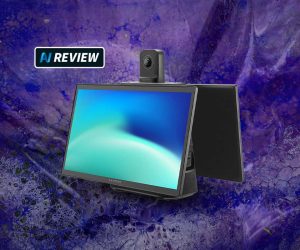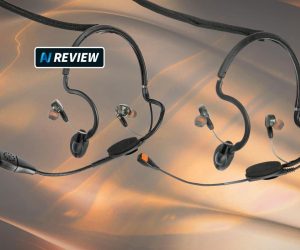
Review: Sennheiser Evolution Wireless Digital
Sennheiser brings app control to frequency management with a new wireless microphone system aimed at the AV market.
Review:/ Preshan John
Nowadays, most wireless microphone systems are smart enough to allow transmitter and receiver to auto-pair the moment they’re switched on, meaning you can start using the product virtually immediately without being an RF geek.
Things get slightly more complicated as you add channels, as the juggling act of frequency distribution and avoidance of interference begins.
Sennheiser’s new Evolution Wireless Digital (EW-D for short) is a digital UHF system that raises the bar in several areas. Firstly, Sennheiser touts its 134dB input dynamic range as the highest of any wireless mic system currently on the market. Secondly, the 1.9ms latency is stated as the lowest of any digital wireless system currently on the market. Third, and perhaps most notably, the supplementary Smart Assist app is meant to demystify smartphone-based wireless frequency management to the point where anyone can set up and manage several EW Digital channels, even without previous RF knowledge.
Being a digital system means less susceptibility to interference and signal degradation as UHF flies through the air. EW-D transmitters convert analogue audio inputs into digital 1s and 0s then fire this digital signal off to the receiver units via UHF where it’s converted back into analogue audio at the receiver’s outputs. All this happens in 1.9ms.
THE SELLING POINT
Sennheiser wireless microphone systems are no stranger to the live music stage. However Sennheiser says the EW-D was designed with a different habitat in mind – AV installations.
Evolution Wireless Digital isn’t the most networkable, in-depth, capable and powerful wireless mic platform in the world – nor is it trying to be. There are other products which support digital networking and more precise management of a multitude of wireless channels. Where EW-D comes into its own however, is in Sennheiser’s powerful frequency-finding technology for multi-channel setups, presented in a foolproof manner.
This makes EW-D perfect for applications requiring more than one wireless channel, but less than what necessitates a flagship system. In this case, not only does Sennheiser’s EW-D assure outstanding performance as far as RF management is concerned, but you don’t have to be a maths genius to configure it.
David Missall, Technical Application Engineer at Sennheiser, explains: “For corporate or school events, the AV teams don’t have the bandwidth to do extensive frequency scans or battle with settings for wireless systems. These users want a microphone system that is reliable, and just works right away without needing to become or call on an RF expert. For instance, businesses and schools don’t always have a technician to monitor their wireless network and set up their audio system before a lecture or presentation. Evolution Wireless Digital is all about simplicity and ease of use, so even administrators with no formal training can plug-and-play their microphone system using their smartphone and achieve excellent, wireless audio.”
David describes another ideal scenario: “We’ll also see EW-D in public tradeshows, conferences, workshops and other presentation spaces. While these situations don’t require networking, there are typically dozens of wireless systems in the same space. For example, a perfect application would be when someone is presenting at InfoComm or ISE [AV tradeshows]. Typically, there are many other presentations and panels taking place in different rooms. The Evolution Wireless Digital operates in the professional UHF band and will enable the presenter or onsite AV support to easily get set up with the mobile app, despite competing wireless technologies. The system will do the frequency scanning and coordination for you.”
MORE INFO
Sennheiser Evolution Wireless Digital
Digital Wireless Microphone System
PRICE
EW-D 835-S Set: $1349
EW-D SK Set: $1169
CONTACT
Sennheiser:
(02) 9910 6700 or [email protected]
PROS
Easy setup via Smart Assist app
Superb build quality
Handy rack-mount options
CONS
Plastic beltpack transmitter
SUMMARY
With 134dB dynamic range and extremely low 1.9ms latency, Sennheiser Evolution Wireless Digital significantly improves the wireless experience. Notably, the addition of the Smart Assist app to EW-D enables effortless configuration and management of multiple channels for those who aren’t RF savvy.

IN THE HAND
Sennheiser sent us two channels of Evolution Wireless Digital – one SKM-S handheld transmitter with the MMD835 capsule, and another SK beltpack transmitter with instrument input.
The build quality of the Evolution Wireless Digital hardware is excellent. The SKM-S transmitter feels fantastic. The metal construction feels bombproof in your hand and the sleek black finish looks smart and resists fingerprints. The SKM-S supports a number of interchangeable capsules from Sennheiser and Neumann. The lower casing unscrews to reveal the two AA battery slots. Every control on the unit – the slide mute switch, rubber power and link buttons underneath – has a firm and definite feel about it. Compared to the lower-cost plastic XS Wireless transmitters, the EW Digital handset will inspire much more confidence for a house engineer or AV technician seeing it go through multiple hands a day. You get 12 hours of battery life with a lithium ion battery pack, or eight hours from a pair of standard AAs.
The EW-D SK beltpack transmitter is less hefty yet still robust. Housed in a plastic case, the squarish beltpack accepts a screw-lockable 3.5mm TRS input for use with headset and lapel microphones, or instruments. The power button is found in the battery compartment while the mute switch and sync button is on top.
POWER UP
The half-rack EM receiver units have a no-nonsense look about them. Six firm rubber buttons let you navigate functions on the clear and concise screen display. As with most half-rack receivers, both antennas lock into the RF Inputs on the rear of the unit, or you can take cables from here to a paddle receiver. Sennheiser supplies rack mounting plates and accessories should you want to mount a single receiver in a rack space with front-mounted antennas via the RF inputs, or two receivers side by side. Once you’ve plugged in the power adapter, you have both XLR and 1/4-inch jack (balanced/unbalanced) output options.
The initial power up involves a single press on both receiver and transmitter. They found each other in a moment, as indicated by the Link LED lighting up on the receiver unit: amber shows the transmitter is muted, green unmuted.
To check battery level on the transmitter, press the power button once while it’s turned on, and the LED will momentarily flash green, yellow or red to indicate remaining power. The receiver displays a four-bar battery readout too.
SOUND
There isn’t a huge amount to report as far as sound is concerned – Sennheiser has been making mics long enough to do a fantastic job. The SMK-S transmitter with MMD835 dynamic cardioid capsule has a polished and produced tone suited very well to sung vocals. An input dynamic range of 134dB ensures every nuance is translated with clarity. The grille keeps plosives at bay while the body effectively rejects handling noise. The SK beltpack transmitter also feels rugged and reassuring in use. It’s not the smallest or lightest pack on the market or, indeed, in Sennheiser’s range, but certainly compact enough be well suited to almost all work-a-day presentation applications.

BECAUSE I’M APP-Y
App functionality can often be gimmicky or poorly implemented in this type of product, but the way Sennheiser has incorporated app control of the EW-D system leaves little room for criticism. Smart Assist is available for iOS and Android and connects with an EW-D system via low energy Bluetooth, offering real-time setup, management and control of all wireless channels you have set up.
Renaming a receiver in the app immediately reflects on the receiver’s physical screen. You can colour code each receiver, adjust the gain, toggle the transmitter mute lock, sync a transmitter, fine tune frequencies; basically perform most functions on the receiver’s menu from your smartphone.
Of course, the most useful of these functions is the ability to centrally manage a number of receivers simultaneously for the purpose of giving each channel its own frequency. Once all receivers have been added to the app (a simple Bluetooth pairing process), activate an auto-scan for the app to decide where to place each channel in the RF spectrum.
The beauty of EW-D is how the interface hides the depth of functionality taking place behind the scenes. The auto-scan process stretches across a tuning grid with a wide 56MHz of bandwidth (the same as on Sennheiser’s flagship Digital 6000 and Digital 9000 systems) along which up to 90 channels can coexist. Each channel is equally spaced 600kHz from the next, with 2240 manually selectable frequencies for fine tuning. All you see is a few rotating circles on a smartphone screen as the system scours the range for competing signals and potential interferences, then assigns each channel to safe frequencies. Establishing a reliable multi-channel wireless rig couldn’t be easier.
Additionally, the Smart Assist app has a Support Hub where you can access Sennheiser resources to help answer your technical questions on the EW-D system. The app is presented impeccably in a clear, ordered manner that’s very easy to navigate.
For a stress-free, multi-channel wireless solution that doesn’t cut corners on sound quality or reliability, it’s hard to go past Sennheiser’s Evolution Wireless Digital.















RESPONSES